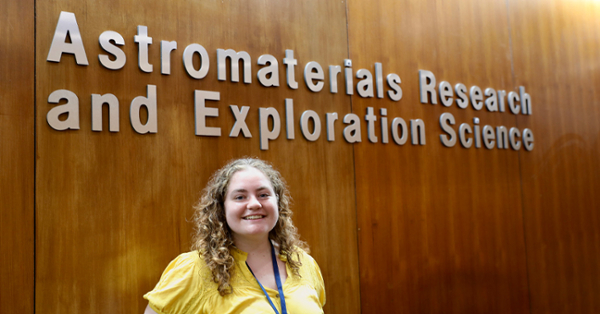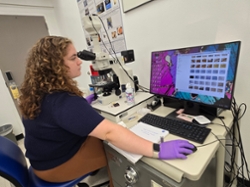Rowan intern reaches for the stars – and touches space dust
Rowan intern reaches for the stars – and touches space dust

Scarlett McCourt, a rising senior majoring in geology, is spending her summer at one of the most iconic locations in space science: NASA’s Johnson Space Center in Houston.
An intern with the Lunar and Planetary Institute (LPI), McCourt, of Vineland, is working onsite alongside Mission Control under the Astromaterials Research and Exploration Science (ARES) division.
Her project? Analyzing extraterrestrial samples – space rocks, to be exact.
“I’m using techniques I learned at Rowan to study tiny dust grains from outer space,” McCourt said. “In the first five weeks, I worked on the Orgueil meteorite, a CI1 chondrite that’s been on Earth for 150 years. It’s incredibly rare and altered by water, which means its parent asteroid likely had water on it.”
With a GPA of 3.963, a minor in Geographic Information Science (GIS) through the School of Earth & Environment, and an honors concentration, McCourt is well-prepared for the challenge. Her work involves meticulous sample preparation – handling particles just micrometers in size, less than the width of a human hair.
“Most of my time is spent under microscopes, observing textures and morphology. The preparation is the hardest part, but it’s also the most valuable,” she said.
Landing the internship was highly competitive and just nine applicants were selected this summer.
McCourt’s mentors at LPI include Christopher Snead, Ph.D., a lead curator ensuring samples remain uncontaminated, and Lindsay Keller, Ph.D., a researcher specializing in interplanetary dust particles (IDPs). These particles, dating back 4.5 billion years, offer glimpses into the early solar system—and even stars that existed before it.
“The IDPs are the real focus,” McCourt explained. “They help us understand environments that existed long before Earth.”

Her experience has included rare access to so-called “clean labs,” specialized facilities with extremely low levels of potential contamination, and a tour of NASA’s Neutral Buoyancy Lab, where astronauts train underwater.
“This is what science has always looked like in my mind – and now I get to do it,” she said.
Despite her deep involvement in space science, McCourt doesn’t see herself leaving Earth’s bounds as an astronaut any time soon.
“I’m not sure I have that level of bravery,” she laughed.
Looking ahead, she’s planning for graduate school, aiming for a Ph.D. and a postdoc focused on nano globules—mysterious, minuscule particles that are notoriously difficult to analyze. Her ultimate goal? A career in curation, whether at NASA, a natural history museum, or a research institution.
“I love this work. The hands-on experience I’m getting – especially with sample preparation – is something you can’t learn anywhere else. It really is out of this world, and it’s going to make me stand out.”